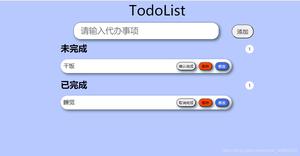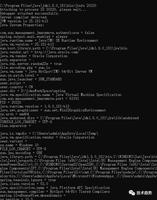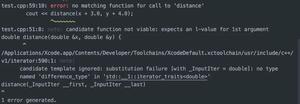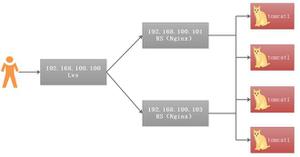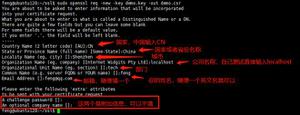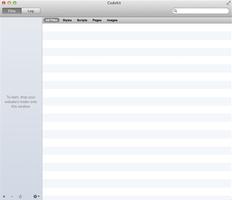使用XKit开发XMLBeans
XMLBeans 允许你以一种友好的方式来操作 XML 文档,它是一种把 XML (可移植的数据)和 JAVA 编程语言(可移植的代码)绑定在一起的工具。它的优点在于:你可以使用 XML 和 XML Schema 灵活性来设计数据模式和接口,然后很自然地把它们映射成对应的 JAVA 语言代码,这样就可以在任何 JAVA 应用环境中访问和修改 XML 实例数据。
虽然《 dev2dev 创刊号》中已经有一篇文章(《 XMLBeans :两方面都是最佳方案》,以下简称《最佳方案》)对 XMLBeans 作了简单论述,并给了一个订单的例子,但却没有如何使用 XKit 来开发 XMLBeans 的内容,因此本文将侧重于这方面的介绍,所以内容与《最佳方案》并不冲突。
一. XKit的获得及配置
1 .XKit 的获得
XMLBeans 可以从 BEA 公司的 http://workshop.bea.com/xmlbeans/xmlbeans.zip 站点下载。解压缩后,有一个 xkit 的目录,内容包括:
| ./lib/xbean.jar | 大小为 3492KB ,是 XMLBeans 的实现类库,支持的 JDK 版本为 JDK1.4.x 。 |
| ./bin | Xkit 的全部命令行脚本。 |
| ./anttask.html | antTask 文档 |
| ./javadoc | com.bea.xml.* 类图 |
| ./src | XMLBeans 的源代码 |
| ./schemas | 些 schemas 的例子 |
2.XKi的配置
确保安装了 JDK 1.4.x ,并且 java[.exe] 、 javac[.exe] 、 jar[.exe] 在 PATH 中, XMLBeans 的 bin 目录也在 PATH 中。设置环境变量 XMLBEANDIR ,值为 ./lib 目录路径,如在 WINDOWS 下: SET XMLBEANDIR=G:\bea\xkit\lib
二. XKit的使用
1. 编译Schema
通过执行 scomp 命令来编译 Schema , scomp 的用法为:
G:\bea\xkit\bin>scomp
Compiles a schema into XML Bean classes and metadata.
Usage: scomp [opts] [dirs]* [schema.xsd]* [service.wsdl]* [config.xsdconfig]*
Options include:
-cp [a;b;c] - classpath
-d [dir] - target binary directory for .class and .xsb files
-src [dir] - target directory for generated .java files
-srconly - do not compile .java files or jar the output.
-out [result.jar] ? 指定输出的 Jar 文件名,如 output.jar
-dl - permit network downloads for imports and includes (default is off)
-noupa - do not enforce the unique particle attribution rule
-nopvr - do not enforce the particle valid (restriction) rule
-quiet - print fewer informational messages
-license 打印 XMLBeans 的 license 文件内容
对于《最佳方案》中的 Order.xsd 文件内容为:
清单 1:Order.xsd
< xs:schema targetNamespace =" http://www.ikigo.com/bods " xmlns =" http://www.ikigo.com/bods " xmlns:xs =" http://www.w3.org/2001/XMLSchema " version =" 1.0 ">< xs:element name =" order ">
< xs:complexType >
< xs:sequence >
< xs:element ref =" header "/>
< xs:element ref =" lines "/>
</ xs:sequence >
</ xs:complexType >
</ xs:element >
< xs:element name =" header ">
< xs:complexType >
< xs:sequence >
< xs:element ref =" customer "/>
< xs:element ref =" po "/>
</ xs:sequence >
</ xs:complexType >
</ xs:element >
< xs:element name =" customer " type =" xs:string "/>
< xs:element name =" po " type =" xs:int "/>
< xs:element name =" lines ">
< xs:complexType >
< xs:sequence >
< xs:element ref =" line " minOccurs =" 0 " maxOccurs =" unbounded "/>
</ xs:sequence >
</ xs:complexType >
</ xs:element >
< xs:element name =" line ">
< xs:complexType >
< xs:sequence >
< xs:element ref =" no "/>
< xs:element ref =" item "/>
< xs:element ref =" price "/>
< xs:element ref =" qty "/>
</ xs:sequence >
</ xs:complexType >
</ xs:element >
< xs:element name =" no " type =" xs:int "/>
< xs:element name =" item " type =" xs:string "/>
< xs:element name =" price " type =" xs:float "/>
< xs:element name =" qty " type =" xs:int "/>
</ xs:schema >
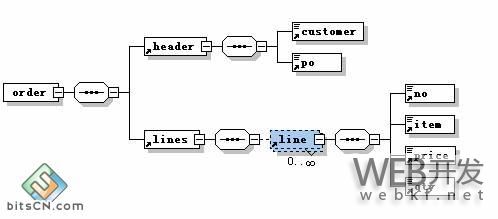
编译 Order.xsd 生成的 Jar 文件为 Order.jar ,命令为:
G:\bea\xkit\bin>scomp ?out Order.jar Order.xsd
Loading schema file Order.xsd
Time to build schema type system: 2.093 seconds
Time to generate code: 5.918 seconds Compiled types to Order.jar
2. XMLBeans的使用
确保 xbean.jar, Order.jar 在 CLASSPATH 中。清单 2 是符合 Order.xsd 的示例 XML 文档,我们将编写一个程序来统计这个订单的总费用。
清单 2:Order.XML
<?xml version="1.0"?>< order xmlns =" http://www.ikigo.com/bods ">
< header >
< customer > Hitesh Seth </ customer >
< po > 10001 </ po >
</ header >
< lines >
< line >
< no > 1 </ no >
< item > Item 1 </ item >
< price > 100 </ price >
< qty > 100 </ qty >
</ line >
< line >
< no > 2 </ no >
< item > Item 2 </ item >
< price > 50 </ price >
< qty > 50 </ qty >
</ line >
< line >
< no > 3 </ no >
< item > Item 3 </ item >
< price > 75 </ price >
< qty > 75 </ qty >
</ line >
</ lines >
</ order>
统计订单总费用的程序为 :
清单3:TotalPrice.java
import com.bea.xml.*;import java.io.*;
import com.ikigo.bods.*;
import com.ikigo.bods.LineDocument.*;
import com.ikigo.bods.OrderDocument.*;
public class TotalPrice {
public static void main(String[] args) throws Exception {
OrderDocument doc =
(OrderDocument) OrderDocument.Factory.parse(new File("Order.xml"));
Order order = doc.getOrder();
Line[] lines = order.getLines().getLineArray();
float amt = 0;
for (int i = 0; i < lines.length; i++) {
amt += lines[i].getQty() * lines[i].getPrice();
}
System.out.println("Order Value: " + amt);
}
}
程序中使用了 OrderDocument.Factory.parse() 方法从磁盘文件中构造一个 OrderDocument 对象 doc ,然后通过 doc.getOrder().getLines().getLineArray() 方法得到 line 对象,并通过 FOR 循环统计订单总额。
3. XmlCursor的使用
XmlCursor代表着 XML 文档中两个逻辑令牌之间的位置。令牌本身不作为对象暴露,但是它们的类型和属性则可以通过 XmlCursor 去引用。使用 XmlCursor ,你可以通过 execQuery() 和 selectPath() 去执行 XQuery 和 XPath 表达式,对 XML 文档作 Inserting, Moving, Copying, Removing 操作。
使用 XmlCursor 重新改写后的 TotalPrice.java 如清单 4 所示。
清单4:TotalPrice.java
import com.bea.xml.*;import java.io.*;
import com.ikigo.bods.*;
import com.ikigo.bods.LineDocument.*;
import com.ikigo.bods.OrderDocument.*;
public class TotalPrice {
public static void main(String[] args) throws Exception {
OrderDocument doc =
(OrderDocument)OrderDocument.Factory.parse(
new File("Order.xml"));
Order order = doc.getOrder();
float amt = 0;
XmlCursor cursor = order.getLines().newCursor();
cursor. toFirstChild ();
do {
Line line = (Line)cursor.getObject();
amt += line.getQty() * line.getPrice();
}
while (cursor. toNextSibling ());
System.out.println("Order Value: " + amt);
}
}
4.XQuery的使用
使用 XmlCursor 的 execQuery () 方法可以执行 XQuery 语句。使用清单 5 的程序可以列出 Order.xml 文档中订购数量大于 50 的行。
清单5:XQuery .java
import com.bea.xml.*;import java.io.*;
import com.ikigo.bods.*
public class XQuery {
public static void main(String[] args) throws Exception {
OrderDocument doc =
(OrderDocument)OrderDocument.Factory.parse(new File("Order.xml"));
String query = " declare namespace o='http://www.ikigo.com/bods'";
query += " //o:line[o:qty>50]";
XmlCursor cursor = doc.newCursor().execQuery(query);
System.out.println(cursor.xmlText());
}

| 作者简介 | |
| 经乾是(dev2dev ID: jq75) BEA系统(中国)有限公司 渠道部技术顾问 | |
以上是 使用XKit开发XMLBeans 的全部内容, 来源链接: utcz.com/p/205788.html

